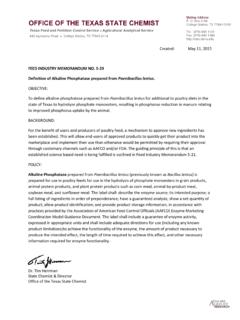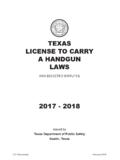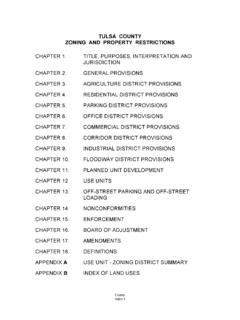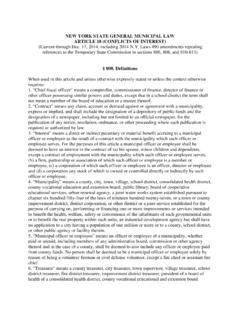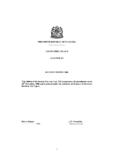Transcription of TEXAS ADMINISTRATIVE CODE TITLE 4. AGRICULTURE …
1 TEXAS ADMINISTRATIVE CODE. TITLE 4. AGRICULTURE . chapter 61. commercial feed rules . (Amended January 1, 2019). Adopted by the TEXAS feed AND FERTILIZER CONTROL SERVICE. Under the TEXAS AGRICULTURE CODE (1981). (As amended). TEXAS A&M University System TEXAS Agricultural Experiment Station Office of the TEXAS State Chemist Tim Herrman, State Chemist & Director College Station, TX. Website: CONTENTS. Section Page SUBCHAPTER A. GENERAL PROVISIONS. Definitions .. 1. commercial feed .. 3. SUBCHAPTER B. LICENSING. Application for Licensing .. 4. SUBCHAPTER C. LABELING. General Label Restrictions .. 4. Labeling commercial feed .. 6. Labeling of Customer-Formula feed .. 31. SUBCHAPTER D. CHANGES IN LICENSING. Redesignation of 32. SUBCHAPTER E. LABEL REVIEW. Label Review .. 33. SUBCHAPTER F. INSPECTION FEE. Assessment.
2 34. SUBCHAPTER G. INSPECTION, SAMPLING, AND ANALYSIS. Sampling and Analytical Procedures .. 34. Analysis of Customer-Formula feed .. 35. Cottonseed Screenings: Sampling, Analysis, and Labeling .. 35. Analytical Variations .. 37. SUBCHAPTER H. ADULTERANTS. Poisonous or Deleterious Substances .. 37. General Provisions for Ammoniating Aflatoxin-Contaminated Corn, Cottonseed, and/or Cottonseed Meal .. 39. General Provisions for Blending Aflatoxin-Contaminated Corn or Cottonseed .. 41. General Provisions for the Use of Aflatoxin Binding Agents in Customer Formula feed .. 42. SUBCHAPTER I. GOOD MANUFACTURING PRACTICES. Regulation of Medicated feed Mills .. 43. SUBCHAPTER J. ADMINISTRATIVE HEARINGS. Cost of Preparing Agency Record .. 43. SUBCHAPTER A. GENERAL PROVISIONS. Definitions Except where otherwise provided, the terms and definitions adopted by the Association of American feed Control Officials in the last published edition of the annual Official Publication are hereby adopted by reference as the terms and definitions to control in this TITLE .
3 The publication is available from the Association of American feed Control Officials. In addition, the following words and terms, when used in this TITLE , shall have the following meanings, unless the context clearly indicates otherwise: (1) Act - TEXAS commercial feed Control Act, TEXAS AGRICULTURE Code, chapter 141, 1981, as amended. (2) Additive - An ingredient or combination of ingredients added to the basic feed mix or parts thereof to fulfill a specific need which becomes a component of or affects the characteristics of a feed or food if such substance is not generally recognized as safe under the conditions of its intended use. (3) Ammoniated Corn - The product obtained by treating whole corn containing no more than 500 parts per billion (ppb) aflatoxin with anhydrous ammonia under specified conditions of temperature and pressure approved by the Service.
4 Ammoniated corn is not to be considered a single ingredient product. (4) Ammoniated Cottonseed - The product obtained by treating whole cottonseed containing no more than 500 parts per billion (ppb) aflatoxin under specified conditions of temperature and pressure approved by the Service. Ammoniated cottonseed is not to be considered a single ingredient product. I. (5) Ammoniated Cottonseed Meal - The product obtained when cottonseed meal is treated with anhydrous ammonia until a pressure of 50 pounds per square inch gauge is reached. It is to be used in the feed of ruminants in an amount not to exceed 20%. of the total ration. Ammoniated cottonseed meal is not to be considered a single ingredient product. (6) Annual Products - commercial feed product packaged in individual containers of five pounds or less only.
5 1. (7) Bagged - Enclosure of feed in any container. (8) Chemical Adulterant - Any compound-natural or synthetic- possessing little or no intrinsic nutritional value, avoidably present at levels inconsistent with its generally accepted use in a feed or unavoidably present at levels in a feed above those authorized by the Service. (9) Container - A bag, box, carton, bottle, object, barrel, package, apparatus, device, appliance, or other item of any capacity into which a feed is packed, poured, stored, or placed for handling, transporting, or distributing. (10) Cottonseed, feed Grade - Sound, mature, unhulled seed of the genus Gossypium left after ginning. Free fatty acids shall not exceed , moisture shall not exceed 20%, and foreign matter shall not exceed 10%. (11) feed Product Produced and Sold by a Farmer - Homogeneous, unprocessed and whole grain, whole seed, and unground hay and any hulls not containing toxins or chemical adulterants for which rules or action levels exist are exempt from licensing, lab- beling and inspection fees.
6 Exempt feed products offered for sale by a farmer must be grown on land solely under the farmer's cont- rol, and be handled and transported under the farmer's control. Green forage crops thus produced, including ensilage produced from an exempt crop, are also exempt. (12) Natural - Describes a feed or feed ingredient produced solely by or derived solely from plants, animals, or minerals, whether unprocessed or processed according to generally accepted industry standards, which has not been exposed to ionizing radiation and does not contain any man-made materials except in such amounts as might occur unavoidably in good processing practices. The term is understood to include as natural flavors and flavorings so designated under 21 CFR (a)(3). (13) Organic - When applied to a product, to a compound, to a mixture of compounds or to a specific constituent used as an ingredient means that the claim of the product, compound, mixture of compounds, or constituent to be organic has been allowed or allowed with restriction by the United States Department of AGRICULTURE 's National Organic Program or the TEXAS Department of AGRICULTURE 's Organic Certification Program.
7 (Materials described as organic must still conform to the TEXAS commercial feed Control Act if they are used in feeds.). (14) Person - Any individual, partnership, corporation, association, governmental subdivision, or public or private organization of any 2. character. (15) Pet Food - Any commercial feed prepared and distributed for consumption by a dog or cat or an animal normally maintained in a cage or tank in or near the household(s) of the owner such as, but not limited to, gerbils, hamsters, birds, fish, snakes, and turtles. (16) Salvage - When applied to an ingredient or combination of ingre-- dients, refers only to those products that have been damaged by natural causes, such as fire, water, hail, or windstorm, or by con- veyance mishap. Does not apply to recovered production line products which are suitable for reprocessing.
8 (17) Service - TEXAS feed and Fertilizer Control Service. (18) Toxin - Any compound causing adverse biological effects including, but not limited to, poisons, carcinogens or mutagens, produced by an organism avoidably present at any level or unavoidably present at levels in a feed above those authorized by the Service. (19) Weed Seeds - Those seeds declared prohibited or restricted noxious weed seeds by the TEXAS AGRICULTURE Code, (concerning Noxious Weed Seeds). (20) Wildlife - Any feral animal, any animal not normally considered as domesticated in TEXAS or any animal living in a state of nature. commercial feed (a) Whole grain and seeds distributed with labels which suggest - by word, by picture or by seller representation - that they may be fed to wildlife are commercial feeds under the Act, (e). (b) All feed materials are considered commercial feeds except: (1) those exempted under the Act, (c) referring to commercial feed ; and (2) salvage feed materials.
9 (c) commercial feeds may not contain: (1) any adulterants as listed in the Act, referring to distribution of adulterated feed ; or (2) salvage feed materials. 3. SUBCHAPTER B. LICENSING. Application for Licensing (a) A facility shall not be granted a license unless and until: (1) it has filed a completed application form and other information necessary for the conduct of the Service's business; and (2) paid the appropriate fees. (b) No facility shall distribute commercial feed in TEXAS until it has received affirmative notification of its licensing either originally or as amended. (c) The Service may require the applicant to submit evidence satisfactory to the Service respecting the safety and efficacy of any of its commercial feeds, including, but not limited to, labels and labeling, prior to approval of a license application: (1) if any feed contains an additive (including drugs, special purpose and/or non-nutritive additives) not previously recognized as safe and effective by the United States Food and Drug Administration for its labeled use or does not possess GRAS animal status; or (2) if any feed normally exempt, but adulterated, so special control by the Service is necessary, including, but not limited to, those feeds incorporating mycotoxin- contaminated ingredients, ammoniated ingredients or animal litter.
10 SUBCHAPTER C. LABELING. General Label Restrictions (a) All labeling information required by Sections or of the Act or by this TITLE shall appear in its entirety on one side of the label or one side of the feed container, except directions for use or precautionary statements, which shall appear in a prominent place on the label or container, but not necessarily on the same side of such label or container as other required label information. When directions for use or cautionary statements appear on a different side of the label or container 4. than its principal display panel, such principal display panel shall bear a reference to such information ( , See back for directions for use ). (b) No labeling information required by the Act or this TITLE shall be obscured or subordinated by other statements or designs.
